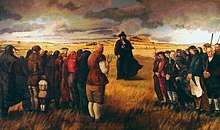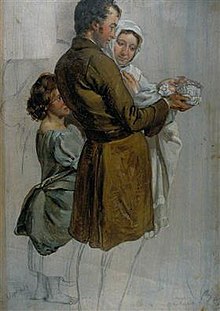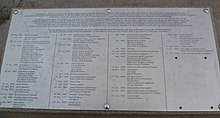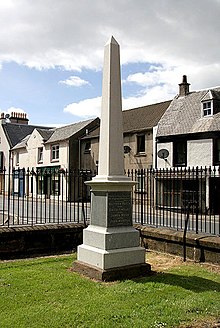John Nisbet (1627–1685) was a Scottish covenanter who was executed for participating in the insurgency at Bothwell Brig and earlier conflicts and for attending a conventicle.[5][6][7][8] He took an active and prominent part in the struggles, of the Covenanters for civil and religious liberty. He was wounded and left for dead at Pentland in 1666 but lived and fought as a captain at Bothwell Bridge, in 1679. He was subsequently seized and executed as a rebel.[9] He was a descendant of Murdoch Nisbet, a Lollard who translated the Bible into the Scots language.
John Nisbet of Hardhill | |
|---|---|
 conventicle near Loudoun Hill | |
| Born | 1627 |
| Died | 4 December 1685 (executed) Grassmarket, Edinburgh |
| Buried | |
| Allegiance | |
| Rank | Captain |
| Battles / wars | Battle of Rullion Green Battle of Drumclog Battle of Bothwell Bridge |



Life
editHe was the son of James Nisbet an Ayrshire tenant farmer at Drakemyre, and his wife, Jane Gibson.[10] He travelled to mainland Europe where he participated in the Thirty Years' War as a professional soldier. He attended the 1650 coronation of Charles II at Scone, where he subscribed the covenant, swearing his allegiance to ‘all the acts of reformation attained to in Scotland from 1638 to 1649’.[11] After returning to the family home at Hardhill, near Loudoun, he married Margaret Law in 1651.
In 1664 he incurred the displeasure of the Episcopalian incumbent of his parish, for having had a child baptized by one of the ejected ministers.[12] The curate declared from the pulpit, that he intended to excommunicate him next Lord's day, but was prevented by sudden death.
After the Restoration he took an active and prominent part in the struggles of the covenanters for religious and civil liberty. He refused to countenance the curates, and attended the ministrations of the ‘outed’ ministers, renewed the covenants at Lanark in 1666, and was one of the small band who published the declarations of the Societies at Rutherglen, Glasgow, and Sanquhar. He fought at Rullion Green (28 Nov. 1666) till, covered with wounds, he fell down and was stripped and left for dead upon the field. At nightfall, however, he crept away unobserved, and lived to take part in the engagements at Drumclog (1 June 1679) and Bothwell Brig (22 June), where he held the rank of captain. For this he was denounced as a rebel and forfeited, three thousand merks (£165 sterling) being offered for his head.[6] On 16 April 1685, Nisbet and Alexander Peden was almost captured in Nisbet's house.[13] In November 1685 he was surprised, with three others, at a place called Midland, in the parish of Fenwick, Ayrshire, his captor being a cousin of his own, Lieutenant Robert Nisbet.[14][15] His companions were instantly shot, but for the sake of the reward he was spared, and, being brought to Edinburgh, was tried[16] and condemned to death.[6]
Death
editNisbet was eventually captured at Fenwick and following trial was executed in the Grassmarket in Edinburgh on 4 December 1685 by hanging.[17] Nisbet is buried at Greyfriars Kirkyard in Edinburgh, and there is a memorial monument at Loudoun Parish Kirk in Newmilns.[citation needed]
Family
editHe married Margaret Law in 1651.[18] By his wife, Margaret Law, he had several children, but only three sons survived him, namely, Hugh, James, and Alexander.[12][19] Serjeant James Nisbet was son to John Nisbet of Hardhill, and died in 1726, in Edinburgh Castle. His diary is chiefly religious. For extracts see Appendix to "Memoirs of Veitch and Brysson." His speaking portrait of Peden will be found in "The Fifty-Years' Struggle," by Dodds, p. 339.
Works
editWith a short account of his last words on the Scaffold. 4 December 1685.[10][20] Dr. Tweedie said: "Few, perhaps, would now approve of all the sentiments emitted by John Nisbet; but there can be as few who do not admire the fortitude with which he endured for what he reckoned the truth, and the patience with which he suffered rather than consent to violate his conscience or compromise his convictions.". [The first edition appeared in 1718, with a preface by James Nisbet his son, then in Edinburgh Castle.]
See also
editReferences
editCitations
edit- ^ Crookshank 1812, 311.
- ^ Wodrow 1835b, 235-236.
- ^ Hewison 1913, 494-495.
- ^ a b Hewison 1913, 394.
- ^ Wodrow 1835b.
- ^ a b c Paton 1895.
- ^ Wells 2004.
- ^ Thomson 1903, 97ff.
- ^ Lee 1903.
- ^ a b Nisbet 1847.
- ^ Howie 1870, 504.
- ^ a b Anderson 1877.
- ^ M'Crie 1847.
- ^ Paton 1929, p. xxxvii.
- ^ Paton 1929, p. 214.
- ^ Paton 1929, p. 229-231.
- ^ Paton 1930, p. 342.
- ^ Thomson 1903, 290.
- ^ Paton 1930, p. 376.
- ^ Howie 1846, 523-535.
- ^ Thomson 1871, 288-300.
- ^ Thomson 1903, 131.
- ^ Thomson 1903, 292.
- ^ Howie 1846, 428-436.
- ^ Wodrow 1828.
Sources
edit- Anderson, William (1877). "John Nisbet of Hardhill". The Scottish nation: or, The surnames, families, literature, honours, and biographical history of the people of Scotland. Vol. 3. A. Fullarton & co. p. 256. This article incorporates text from this source, which is in the public domain.
- Crookshank, William (1812). The history of the state and sufferings of the Church of Scotland, from the Restoration to the Revolution. With an introd., containing the most remarkable occurrences relating to that Church from the Reformation. Vol. 2. Edinburgh: Thomas Turnbull. pp. 311-315.
- Fountainhall, Lord (1848). Laing, David (ed.). Historical Notices of Scotish Affairs: Selected from the Manuscripts of Sir John Lauder of Fountainhall. Vol. 1. Edinburgh: T. Constable, printer to Her Majesty. pp. 676, 681.
- Hewison, James King (1913). The Covenanters. Vol. 2. Glasgow: John Smith and son. This article incorporates text from this source, which is in the public domain.
- Howie, John, ed. (1846). The Last Words and Dying Testimonies of the Scots Worthies, containing The Cloud of Witnesses for the Royal Prerogatives of Jesus Christ, being the last speeches and testimonies of those who suffered for the truth in Scotland, since the year 1680; and Naphtali, or the wrestlings of the Church Of Scotland for The Kingdom Of Christ, together with Other Testimonies Collated From Memoirs of The Lives Of The Worthies, and other valuable historical documents only to be found in old published collections and original manuscripts. Glasgow: W. R. M'Phun. pp. 192-200.
- Howie, John (1870). "John Nisbet of Hardhill". In Carslaw, W. H. (ed.). The Scots worthies. Edinburgh: Oliphant, Anderson, & Ferrier. pp. 494-507. This article incorporates text from this source, which is in the public domain.
- Johnston, John C. (1887). Treasury of the Scottish covenant. Andrew Elliot. pp. 356, 394. This article incorporates text from this source, which is in the public domain.
- Lee, Sidney, ed. (1903). "Nisbet, John". Index and Epitome. Dictionary of National Biography. Cambridge University Press. p. 949. This article incorporates text from this source, which is in the public domain.
- M'Crie, Thomas (1847). The Bass rock: Its civil and ecclesiastic history. Edinburgh: J. Greig & Son. p. 45. This article incorporates text from this source, which is in the public domain.
- M'Crie, Thomas (1875). The story of the Scottish church : from the Reformation to the Disruption. London: Blackie & Son. pp. 349.
- Nisbet, John (1847). Tweedie, William King (ed.). Select biographies. Vol. 2. Edinburgh: Printed for the Wodrow Society. pp. 371–414.
- Paton, Henry (1895). "Nisbet, John (1627?-1685)". In Lee, Sidney (ed.). Dictionary of National Biography. Vol. 41. London: Smith, Elder & Co. This article incorporates text from this source, which is in the public domain.
- Paton, Henry, ed. (1929). The register of the Privy Council of Scotland. 3rd series. Vol. 11 1685-1686. To be purchased directly from H.M. STATIONERY OFFICE at the following addresses 120, George Street, Edinburgh.
- Paton, Henry, ed. (1930). The register of the Privy Council of Scotland. 3rd series. Vol. 12 1686. To be purchased directly from H.M. STATIONERY OFFICE at the following addresses 120, George Street, Edinburgh. pp. 342, 376.
- Rogers, Charles (1871). Monuments and monumental inscriptions in Scotland. Vol. 1. London: Grampian Club. p. 394.
- Sime, William (1837a). History of the covenanters in Scotland. Vol. 1. J. Johnstone. pp. 304-305.
- Sime, William (1837b). History of the covenanters in Scotland. Vol. 2. J. Johnstone. pp. 275-279.
- Smellie, Alexander (1903). "The Killing Times". Men of the Covenant : the story of the Scottish church in the years of the Persecution (2 ed.). New York: Fleming H. Revell Co. pp. 166-168.
- Thomson, J. H. (1903). Hutchison, Matthew (ed.). The martyr graves of Scotland. Edinburgh: Oliphant, Anderson & Ferrier. pp. 97-100. This article incorporates text from this source, which is in the public domain.
- Thomson, John Henderson (1871). A cloud of witnesses, for the royal prerogatives of Jesus Christ : being the last speeches and testimonies of those who have suffered for the truth in Scotland, since the year 1680. Edinburgh: Oliphant, Anderson, & Ferrier. pp. 449-472. This article incorporates text from this source, which is in the public domain.
- Veitch, William; Brysson, George (1825). M'Crie, Thomas (ed.). Memoirs of Mr. William Veitch, and George Brysson. Edinburgh; London: W. Blackwood; T. Cadell.
- Wells, Vaughan T. (2004). "Nisbet, John". Oxford Dictionary of National Biography (online ed.). Oxford University Press. doi:10.1093/ref:odnb/20201. (Subscription or UK public library membership required.)
- Wodrow, Robert (1835a). Burns, Robert (ed.). The history of the sufferings of the church of Scotland from the restoration to the revolution, with an original memoir of the author, extracts from his correspondence, and preliminary dissertation. Vol. 1. Glasgow: Blackie, Fullarton & co., and Edinburgh: A. Fullarton & co. p. x.
- Wodrow, Robert (1828). Burns, Robert (ed.). The history of the sufferings of the church of Scotland from the restoration to the revolution, with an original memoir of the author, extracts from his correspondence, and preliminary dissertation. Vol. 3. Glasgow: Blackie, Fullarton & co., and Edinburgh: A. Fullarton & co. p. 453. This article incorporates text from this source, which is in the public domain.
- Wodrow, Robert (1835b). Burns, Robert (ed.). The history of the sufferings of the church of Scotland from the restoration to the revolution, with an original memoir of the author, extracts from his correspondence, and preliminary dissertation. Vol. 4. Glasgow: Blackie, Fullarton & co., and Edinburgh: A. Fullarton & co. pp. 235-238.